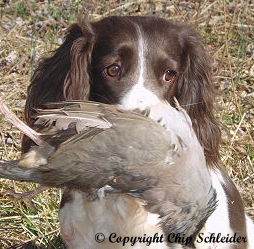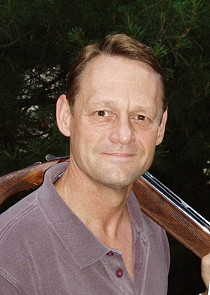
 The November wind was blowing at least twenty miles per hour with a wind chill factor was in the single digits as I closed the breech on my 20 gauge Rizzini on the morning of the first day of our now annual pheasant hunt. I was concentrating on getting the forearm on the shotgun when Gary Urban, our guide for the trip, tapped me on the shoulder. "Dogís gone," he said with his usual economy. Matching his lack of verboseness, I let out the obligatory response, "Oh crap." I immediately realized my mistake. I had momentarily lost eye contact with Dixie. Unable to resist the narcotic bird scent in the air, she had seized the opportunity to take off and hunt with reckless abandon the cornfields of South Dakota.
"After the debacle of the cornfields, we decided to try Dixie in a parcel of land enrolled in the Department of Agricultureís Conservation Reserve Program. Without the high speed pheasant drag strips, known to the farmers as 'corn rows', Dixie performed far better."
It had all started in February of that year when I learned of the unbelievable pheasant hunting to be had around the very small South Dakota town of Presho located about an hour and half west of Mitchell. I had gotten the name of Ron Brodrecht, owner of Buckshot Pheasant Hunts, from a good friend - and I called him up. After explaining his program, Ron asked me if I would like to hunt the first four days of November. "Well...," I replied, "Iím not certain what I have on my calendar for that time, what other dates do you have available?"
"I have the first four days in November," he replied with a level voice.
Not to be outdone, I quickly responded, "Gee, Ron, I guess I will take the first four days in November."
We talked for a while about the pheasant population projections and then as I was about to hang up, Ron asked, "Will you be coming back next year?"
A little rattled, I replied, "Gosh Ron, I havenít been once yet."
He chuckled a little embarrassed, and said, "Well Chip, hereís the thing - everybody always comes back."
I am certain that he could hear my eyebrows knit through the telephone lines. With a self conscious little chortle, I added, "Ron, if thatís the case, somebody has to die to free up a spot."
"Funny you should mention that," he retorted, "the guy from North Dakota who usually takes that time..."
In the interim, I had been busy training Dixie, fly fishing the beautiful streams of Virginia, ticking off items on my 'honey do' list and desperately seeking to find time in my hectic sporting schedule to work my day job. In September, I had sent Dixie to Tony Roettger to be steadied to flush and shot after a summer of preparation. In retrospect, that was not smart on my part. In fact, I can say with the utmost objectivity that sending Dixie to be steadied and then seeking to hunt her in South Dakota on wild birds after undergoing the training was one of the most significant missteps that I made in her training. I think it is the canine equivalent of telling a teenage daughter that she must make an 11:00 curfew on prom night. Not in the cards - too much temptation. Tony did a terrific job of steadying the young bitch; I did an equally impressive
job of unsteadying her in South Dakota. But as always, I am getting ahead of my story.
I looked back to Gary and he said, "I think she went through the cornfield to the left." There were two identical parallel fields extending about one half mile each and separated by roughly a hundred yards. We had parked between the two fields and were planning to hunt each in turn. I looked to my two sons, Christian and Zander (short for Alexander) and they both shrugged; neither had seen her take off. Suddenly, about half way down the leftmost field, Dixie broke out of the corn and began running flat out back toward us. "Damn," Gary snorted, "I think sheís got a bird in her mouth." As she closed the quarter mile that separated us, I could clearly see that she securely held a wriggling, kicking cock pheasant.
To my utter amazement, she delivered the wild, live and undamaged bird to my outstretched hand. I handed the bird, as the rules of engagement required, to my astonished guide. No shot had yet been fired. Dixie remained hupped with a smug, self-satisfied look on her face; a broad grin split mine. I could not let the moment pass. "Gary Iím sorry," I said with a straight face, "Next time I will try to shoot the birds before she retrieves them." But this was not the end of the episode. In the process of dispatching the pheasant, Gary lost his grip and the bird flew away. Having just loaded my Rizzini with 20 gauge 2 ĺ Fiocchi Golden Pheasant No. 5s (a bird killing load if ever there was one), I waited until the cock bird had safely cleared the hunting party and brought it down with a single shot. Dixie, who remained hupped through the process,
made yet the second retrieve of the same bird. It was a moment to savor.
Shortly after that auspicious beginning, I realized the depths of my inadequacies as a dog trainer and handler. Kevin Vaughn, adopted son of Ronís brother, drove Zander down to the end of the cornfield to block for us. We started with a three man front - with me in the middle driving Dixie. She handled well in the waist high corn for the first three turns. Then she took her first of many runners that day... and all hell broke loose. I immediately lost sight of her in the field, but could roughly estimate her location by the movement of the corn. I whistled until I thought my temples would burst, but Dixie completely blew off my commands. About a hundred yards down the field from our position, we marked a rise of at least a hundred birds. Zander was the only one with a shot, as the birds flew directly toward him. He nailed a cock bird as it
turned to his left - a thirty yard crossing shot. Dixie had never marked the birdís fall. She was fixed on a runner that refused to flush until the end of the cornfield. The next cornfield was repetition of the first. Welcome to South Dakota, Chip.
After the debacle of the cornfields, we decided to try Dixie in a parcel of land enrolled in the Department of Agricultureís Conservation Reserve Program. Without the high speed pheasant drag strips, known to the farmers as 'corn rows', Dixie performed far better. Hunting the corn rows, however, had greatly eroded her steadiness. Although she remained reasonably steady through the first couple of flushes, increasingly she began to creep with each successive flush. My meager dog handling abilities at this juncture did not enable me to control the high powered springer. The sheer volume of birds, the prodigious amount of scent in the air coupled with her innate drive and talent overwhelmed me. By the end of the day, she was no longer hupping at the flush; she was back to being an unabashed bird chaser. There was nothing I could do to control her.
"I think that it was here in the Dakotas that I truly learned not to exceed the limits of my own dog handling abilities - or those of my dogs - in highly demanding field situations. Conversely, I observed that, with proper training and handling, there is no finer dog than a spaniel for hunting pheasants."
And so it went for the next few days of the hunt.
I learned many dog handling lessons during that inaugural hunt in the environs of Presho. Most of these group nicely in the "what a novice handler should not to do with a young newly trained, inexperienced dog in South Dakota" category. However, these are lessons that all who take up the sport of bird hunting with flushing dogs will experience at some point in their sporting careers. For me, I now appreciate greatly the value of practice handling a young dog in field situations before going to the big sky country. I think that it was here in the Dakotas that I truly learned not to exceed the limits of my own dog handling abilities - or those of my dogs - in highly demanding field situations. Conversely, I observed that, with proper training and handling, there is no finer dog than a spaniel for hunting pheasants.
Although I despaired of Dixieís and my own handling performance during that first pheasant hunt, it was indeed a remarkable series of days in the field. Never in my life, not even during the Texas bumper quail years of the 1970s, had I seen so many wild birds. After we limited out on pheasants, we hunted sharptail grouse and prairie chickens with equal enthusiasm. Most importantly, however, it was time of bonding with my two sons - one of whom was only weeks away from being commissioned as an Army Second Lieutenant destined for combat service in Iraq. Years after the hunt, the three of us often reminisce about the final day of the hunt. Late in the afternoon, we hunted an enormous dry lake bed covering many acres. With Dixie in the lead, we entered the ancient cattails that had once thrived around the lake bedís edges, but were now
trampled and blown down by wind. In this near perfect habitat, we were almost instantly rewarded by an enormous flush of three hundred or more pheasants. All of us were too stunned shoot. Overcome with the beauty of the sight, we watched as the birds flew into the fading light. Dixie too, it seems, was struck by the flush, for she hupped and remained so until I called her to me for a much deserved scratch behind the ears and a tummy rub.
Authorís note: this is the third in a series of articles that chronicle both the development of a talented young spaniel and the rights of passage of an inexperienced trainer and handler.
Part II Part III Part IV
|
|
| Bookstore | Bill Fawcett Reviews | Advertise | Classifieds | Resources | Events | Point Standings | Archives | Spaniel Journal | |
|
|
Copyright © Spaniel Journal & L Baughan Webdesign, 2002-2006, all rights reserved worldwide |
|

